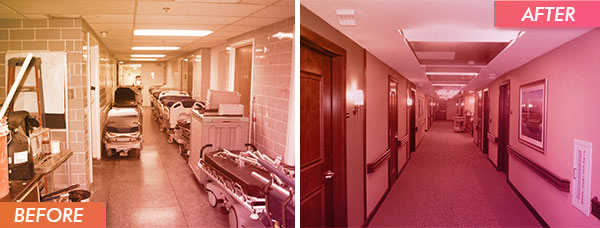It's happening at community hospitals all over America: leadership teams are looking for ways to maintain margins by managing underutilized and non-revenue producing space. Let's look at a real life scenario, and then break down some potential, seemingly non-traditional approaches to a solution.
Scenario:
Your hospital has been operating on an average-daily-census of 67% over the past 18 months. Flat utilization rates and stable market share translate to incremental growth (in specific service lines) projected over the next 5-7 years, although the competing hospital has announced plans for a new Cancer Center.
Originally designed in the 1980’s, each semi-private room contains a (shared) single toilet/shower and room configurations that cannot meet today’s standard of care without spending $6 million in a total renovation.
Of the multiple inpatient floors the 3rd floor has remained empty, dark and underutilized for the past 2 ½ years.
The hospital has acquired a small OBGYN practice and new Medical Oncology Group. As part of their negotiated agreement with the physicians, the hospital must accommodate 5,000 square feet for each practice and in close proximity to the hospital.
The solution:
Convert the 3rd floor to a Wellness Center and outpatient clinic to include multiple practices, as well as shared use with the hospital's support spaces and Surgery (in conjunction with updated inpatient / outpatient charges and billing codes) along with a revamped side hospital entry marked, "Outpatient Care".
How and why this could work:
Implementation of "hybrid" OR's have taken root with increasing popularity which leads to exploring alternative applications for "hybrid" healthcare. The challenge then becomes how to effectively utilize the space, in conjunction with a master plan approach for the outpatient clinic space.
Challenges for space allocation begin with analyzing space need versus bed utilization. Historical data and trends on admissions per 1,000 population by age cohort can provide a clear understanding of evolving market dynamics. When market projections are built on segmented MSDRG categories and age cohorts, the results can be remarkably accurate. When the planning process includes interactive work sessions with the medical and surgical specialists, as well as internal planning resources, practice patterns and market share moves can be quantified. The results of such a comprehensive approach cannot be understated, highlighting growth areas and targeted specialty services.
Once service lines are identified, space programming completed and optimum bed utilization is determined, a hospital can then review and compare available areas to space requirements, building access and controls and ultimately financial performance. Facilities should consider continued revamping of underutilized inpatient (I.P.) units into flexible revenue-producing outpatient (O.P.) care areas.
Use of Hybrid units may start with converting an empty patient wing, or underutilized floor. Essentially, “hybrid” thinking has the potential to convert empty, underutilized space into multidimensional opportunities and leased space. In addition, as hospitals purchase practices and partner with physicians, it may be cost effective to negotiate the use of in-house clinic space versus the cost of maintaining a free-standing building or out-of-house leased Medical Office space. Reallocation of underutilized space offers various options depending on the facility, such as renovating a single unit or an entire floor.
Advantages to entire floors allows centralized reception and waiting for clinic space, after-hours Wellness Center access and possible separation of building engineering systems. Whereas an advantage to specific units (with appropriate access and controls) may offer specific clinic adjacencies to correlating, existing hospital support functions such as Surgery, Oncology or Imaging. Actual conversions are custom and unique to each facility and therefore requires a unique approach per each business plan.
Additional requirements may result in a possible separate building entry, designated clinic parking spaces and updated way-finding to separate Inpatient and Outpatient access. Additionally many pre-planning budgets often fail to consider requirement renovations to adjacent areas (above or below the remodel), possible updates for building engineering systems and multiple areas or phases to the renovation. That said, energy savings may be found through night-time setbacks and less stringent infection-control requirements (for outpatient areas).
Ultimately, revenue-producing square footage is key to maximizing reimbursements and the bottom-line. How can you reallocate that vacated, antiquated patient space within your facility into vibrant revenue-producing spaces such as clinics and outpatient centers of excellence?
About the Author
David Magner, AIA, NCARB, EDAC, LEED AP, is an architect with more than 10 years of healthcare experience on a variety of project types and sizes, though typically "unique" interior renovations. Hoosier by birth, Southern by marriage, he hopes to help open and manage the GS&P San Destin office (hint… hint…). More on Magner.
Read more posts on GS&P's Dialogue blog
More from Author
Gresham Smith | Oct 16, 2024
How AI can augment the design visualization process
Blog author Tim Beecken, AIA, uses the design of an airport as a case-study for AI’s potential in design visualizations.
Gresham Smith | Aug 17, 2023
How to design for adaptive reuse: Don’t reinvent the wheel
Gresham Smith demonstrates the opportunities of adaptive reuse, specifically reusing empty big-box retail and malls, many of which sit unused or underutilized across the country.
Gresham Smith | May 24, 2023
Designing spaces that promote enrollment
Alyson Mandeville, Higher Education Practice Leader, argues that colleges and universities need to shift their business model—with the help of designers.
Gresham Smith | Apr 24, 2023
Smart savings: Commissioning for the hybrid workplace
Joe Crowe, Senior Mechanical Engineer, Gresham Smith, shares smart savings tips for facility managers and building owners of hybrid workplaces.
Gresham Smith | Mar 20, 2023
3 ways prefabrication doubles as a sustainability strategy
Corie Baker, AIA, shares three modular Gresham Smith projects that found sustainability benefits from the use of prefabrication.
Gresham Smith | Jan 19, 2023
Maximizing access for everyone: A closer look at universal design in healthcare facilities
Maria Sanchez, Interior Designer at Gresham Smith, shares how universal design bolsters empathy and equity in healthcare facilities.
Gresham Smith | Dec 20, 2022
Designing for a first-in-the-world proton therapy cancer treatment system
Gresham Smith begins designing four proton therapy vaults for a Flint, Mich., medical center.
Gresham Smith | Nov 21, 2022
An inside look at the airport industry's plan to develop a digital twin guidebook
Zoë Fisher, AIA explores how design strategies are changing the way we deliver and design projects in the post-pandemic world.
Gresham Smith | Feb 13, 2022
Helping maximize project dollars: Utility coordination 101
In this post, I take a look at the utility coordination services our Transportation group offers to our clients in an attempt to minimize delays and avoid unforeseen costs.
Gresham Smith | May 7, 2021
Private practice: Designing healthcare spaces that promote patient privacy
If a facility violates HIPAA rules, the penalty can be costly to both their reputation and wallet, with fines up to $250,000 depending on the severity.
















